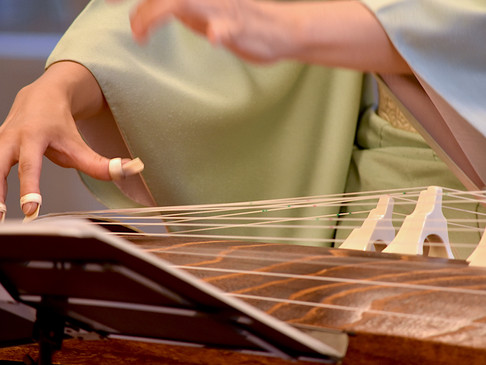The Koto
- NARA Visitor Center & Inn

- Dec 21, 2021
- 2 min read
Updated: Mar 24, 2024
What images spring to mind when thinking of Japan? Mt. Fuji? Geisha? Sumo Wrestlers? Sushi? Any and all of these are perfectly fine answers, but how would you respond to being asked what sounds signify Japan? The cries of "Irasshaimase!"of shop assistants? The high pitched squeals of cicadas in summer? The relentless din of pachinko parlours? Many would think of the classical sound of the koto, but few would actually know what it was, or could even for that matter name it.
The koto is Japan’s national instrument. Kotos are made from pawlonia wood, are about 180cm long and typically have 13 strings stretched over moveable bridges along their length. Koto players pluck the strings using picks on their right thumb, index and middle fingers, with their bare ring and little finger and occasionally with their left hand.

The left hand’s main job is to adjust the pitch and tone of the strings by changing the position of the string bridges, or by changing the strings’ tension by applying pressure to them. This flexibility allows the koto to produce both the traditional Japanese sound it is associated with, and the “do, re, mi” arrangement of western music.

The ancestor of the koto, the zheng, was introduced to Japan by China in the early 8th century. Originally it was a court instrument used in Imperial court functions and ceremonies with accompaniment from other instruments. The koto’s sound and elegant design became popular with Japan’s wealthy elite who began using it as a solo instrument.
During the early Edo period, in the 17th century, Yatsuhashi Kengyo, a blind but highly gifted musician, developed a new way to tune the koto. The adjustments he invented, known as Kumi uta or song building, allowed greater flexibility in the composition and performance of koto music, changing it into the form still practiced today.

He is thus known as the "Father of Modern Koto. "As western music made its way to Japan from the late 19th century onward, koto players were inspired to incorporate it into their music, and to expand the capabilities of the koto by creating larger 17-25 string versions.
Where was the first time you heard the koto?
Have you ever tried to play one?
Do you think it represents "The Sound of Japan" or would you go for the Shamisen or Taiko Drums?
Author: NARA Visitor Center & Inn








Comments